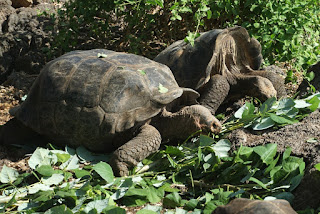May 11, 2019
May 11, 2019
Just after 10pm last night, we checked out of our hotel early and met our driver in the lobby. He ferried us from Quito to an adjoining Andean ridge which has the new Quito airport. The journey takes almost an hour. Just before we left we learned that our 1:45am flight is significantly delayed. We spend most of the night sitting in uncomfortable airport seating.
Early in the morning, we finally board our flight. Unfortunately our big comfy Business seats don’t recline making it difficult to get any shut-eye. Incredibly, the flight attendant wanted to feed us a meal.
Because of our delayed flight, we have to reschedule our connecting flights. On a different airline, no less. On the way, I was amused to see us cross the Overseas Highway to Key West. I like it when varied parts of the trip cross paths. Once in Miami we took the opportunity to do our Global Entry interview with the Border Patrol. Of course our connecting flight was delayed too. Fortunately flying First Class has some perks and we were able to use an Avianca Lounge. I didn’t realize but these First Class Lounges are wonderful oases when enduring long flight delays. They have comfortable seats, good WIFI, food, and free drinks.
Our flight to Houston took an hour longer because of bad weather. I guess weather is causing trouble all over and it ripples to every flight. Thankfully it is always sunny in Tucson, especially in May, so our last leg will be good. Or so we thought. Just before landing the pilot says we are diverting to Phoenix because of high winds. Now I remember why I hated business travel. Expecting to get bussed to Tucson, we were surprised to hear the Pilot tell us to stay put. They refueled the plane and we were back in the air. We finally made it home at midnight after being awake way too long.
Just after 10pm last night, we checked out of our hotel early and met our driver in the lobby. He ferried us from Quito to an adjoining Andean ridge which has the new Quito airport. The journey takes almost an hour. Just before we left we learned that our 1:45am flight is significantly delayed. We spend most of the night sitting in uncomfortable airport seating.
Early in the morning, we finally board our flight. Unfortunately our big comfy Business seats don’t recline making it difficult to get any shut-eye. Incredibly, the flight attendant wanted to feed us a meal.
Because of our delayed flight, we have to reschedule our connecting flights. On a different airline, no less. On the way, I was amused to see us cross the Overseas Highway to Key West. I like it when varied parts of the trip cross paths. Once in Miami we took the opportunity to do our Global Entry interview with the Border Patrol. Of course our connecting flight was delayed too. Fortunately flying First Class has some perks and we were able to use an Avianca Lounge. I didn’t realize but these First Class Lounges are wonderful oases when enduring long flight delays. They have comfortable seats, good WIFI, food, and free drinks.
Our flight to Houston took an hour longer because of bad weather. I guess weather is causing trouble all over and it ripples to every flight. Thankfully it is always sunny in Tucson, especially in May, so our last leg will be good. Or so we thought. Just before landing the pilot says we are diverting to Phoenix because of high winds. Now I remember why I hated business travel. Expecting to get bussed to Tucson, we were surprised to hear the Pilot tell us to stay put. They refueled the plane and we were back in the air. We finally made it home at midnight after being awake way too long.



















































